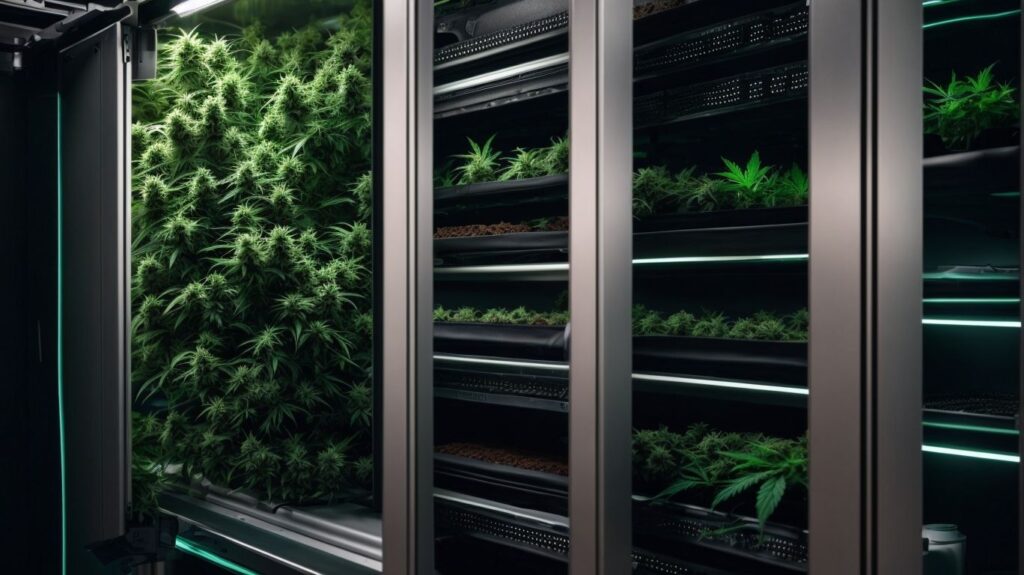Introduction to Automating Cannabis Growing
Cannabis cultivation has come a long way in recent years, with growers constantly seeking ways to improve efficiency, consistency, and convenience. One method gaining popularity among growers is automating various aspects of the growing process. This involves using technology and automated systems to control and monitor temperature, humidity, nutrient delivery, lighting, watering, and pest control.
In this article, we will discuss the benefits of automating cannabis growing and the different systems available for each aspect.
Why Automate Cannabis Growing?
-
- Increased Efficiency
Automated systems can perform tasks at a faster rate and with more precision than manual labor. This leads to a more efficient growing process, reducing the time and resources needed for a successful harvest.
-
- Consistency in Growth
Automation ensures that environmental factors, such as temperature and nutrient levels, are kept at optimal levels consistently. This results in more uniform and higher quality plants, making it easier to produce a consistent product.
-
- Convenience and Time-saving
With automated systems, growers can monitor and control their plants remotely, saving them time and effort. This also allows them to focus on other important tasks, such as monitoring plant health and addressing any issues that may arise.
-
- Cost Savings
Automated systems can save growers money in the long run. By reducing the need for manual labor and optimizing resource usage, growers can save on labor costs and potentially increase their yield.
Automating Temperature and Humidity Control
-
- Importance of Controlling Temperature and Humidity
Temperature and humidity are crucial factors in the growth of cannabis plants. Automated systems can help maintain optimal levels, ensuring the plants are not exposed to extreme temperatures or humidity levels, which can negatively impact growth.
-
- Types of Automated Temperature and Humidity Control Systems
Some examples of automated systems for temperature and humidity control include environmental controllers, which use sensors and timers to maintain ideal levels, and HVAC systems, which can regulate temperature and humidity on a larger scale.
Automating Nutrient Delivery
-
- Benefits of Automated Nutrient Delivery
Automated nutrient delivery systems allow for precise control over the amount and timing of nutrients given to plants. This results in healthier and more vigorous growth, leading to higher yields.
-
- Types of Automated Nutrient Delivery Systems
Some examples of automated nutrient delivery systems include drip irrigation systems and hydroponic systems. These systems can be programmed to deliver specific nutrients at certain intervals, ensuring plants receive the nutrients they need to thrive.
Automating Lighting and Watering
-
- Importance of Proper Lighting and Watering
Light and water are essential for plant growth. Automated systems can ensure that plants receive the right amount of light and water, leading to healthier and more robust plants.
-
- Types of Automated Lighting and Watering Systems
Some examples of automated lighting and watering systems include grow lights with timers and automatic watering systems with sensors that monitor moisture levels and water accordingly.
Automating Pest Control
-
- Common Pests in Cannabis Growing
Pests can be a significant problem for cannabis growers, potentially damaging or destroying entire crops. Automated pest control systems can help detect and eliminate pests before they become a major issue.
-
- Types of Automated Pest Control Systems
Some examples of automated pest control systems include pest traps with sensors that alert growers when pests are present and automated sprayers that release pest-repelling substances.
Conclusion: The Future of Automated Cannabis Growing
With the increasing demand for cannabis and the growing competition in the industry, automating various aspects of the growing process is becoming more prevalent. As technology continues to advance, we can expect to see more sophisticated and efficient systems for automating cannabis cultivation, making it easier for growers to produce high-quality crops with minimal effort.
Key Points:
Automating cannabis growing offers increased efficiency, consistency, convenience, and cost savings. Controlled temperature and humidity play a crucial role in successful cannabis growth, and there are various automated systems available to help maintain optimal levels. Automated nutrient delivery, lighting, watering, and pest control can all contribute to a more streamlined and successful cannabis growing process.
Why Automating Cannabis Growing?
In the world of cannabis cultivation, automation is becoming an increasingly popular technique for streamlining and improving the growing process. But why exactly should growers consider automating various aspects of their cannabis growing? In this section, we will explore the multiple benefits of automation, including increased efficiency, consistent growth, convenience, and cost savings. By understanding the advantages of automation, growers can make informed decisions about how to optimize their growing methods.
1. Increased Efficiency
Utilise automated temperature and humidity control systems to maintain optimal growing conditions consistently. Implement automated nutrient delivery systems to ensure precise and timely feeding of essential nutrients, promoting healthy plant growth. Employ automated lighting and watering systems to provide the appropriate light and water levels, optimising photosynthesis and hydration. Integrate automated pest control systems to detect and address pest issues promptly, safeguarding the plants’ health and yield.
Efficiently automating cannabis growing processes not only streamlines operations but also enhances overall yield and quality. Consider investing in reliable automation technology to achieve consistent, high-quality yields while minimising labour and resource expenses.
2. Consistency in Growth
Implement a consistent watering schedule to ensure plants receive adequate moisture at regular intervals.
Utilize automated lighting systems to maintain uniform and consistent light exposure for optimal plant growth.
Employ a controlled environment, including temperature and humidity, to provide stable conditions conducive to consistent plant development.
Regularly monitor and adjust nutrient delivery systems to meet the plants’ nutritional requirements consistently.
3. Convenience and Time-saving
Implement automated temperature and humidity control systems to maintain optimal growing conditions without manual adjustments, saving time and effort. Utilise automated nutrient delivery systems to ensure plants receive the right amount of nutrients at the right time, streamlining the cultivation process and reducing labour. Employ automated lighting and watering systems to regulate essential growth factors, eliminating the need for manual intervention and freeing up time for other tasks. Incorporate automated pest control systems to detect and address pest issues promptly, preventing potential crop damage and minimising time-consuming manual pest management.
4. Cost Savings
Invest in energy-efficient lighting to reduce electricity expenses.
Opt for automated watering systems to minimise water usage and prevent wastage.
Use smart climate control systems to regulate temperature and humidity, leading to lower utility bills.
Implement an automated nutrient delivery system to ensure precise dosage, preventing overuse and unnecessary expenses.
Pro-tip: Regularly assess the efficiency of your automated systems and conduct maintenance to maximise cost savings over time.
Automating Temperature and Humidity Control
In the world of cannabis growing, maintaining the right temperature and humidity levels is crucial for a successful harvest. Luckily, with advancements in technology, there are now various automated systems that can help with this task. In this section, we will discuss the importance of controlling temperature and humidity in the growing process and explore the different types of automated systems that can make this task more efficient and convenient for growers.
1. Importance of Controlling Temperature and Humidity
The control of temperature and humidity is crucial in cannabis cultivation due to its impact on plant health, growth, and yield. Utilize the following steps to ensure optimal conditions:
- Invest in a reliable hygrometer and thermometer to monitor levels accurately.
- Establish the ideal temperature and humidity range for the specific growth stage of the cannabis plants.
- Utilize automated HVAC systems to maintain consistent temperature and humidity levels.
- Implement dehumidifiers or humidifiers to adjust humidity as needed.
- Ensure proper air circulation and ventilation within the growing environment.
Fact: Maintaining proper temperature and humidity levels is essential for maximising cannabinoid and terpene production in cannabis plants.
2. Types of Automated Temperature and Humidity Control Systems
When considering automated temperature and humidity control systems for cannabis growing, various types are available to cater to different needs and scale of operations.
Centralised Systems: These systems provide control over temperature and humidity for an entire facility from a centralised location, ensuring uniform conditions throughout the space.
Zoned Systems: Ideal for larger facilities, zoned systems allow control over specific areas or zones independently, enabling customised climate management for different growth stages or strains.
Portable Systems: Suited for smaller-scale operations, portable systems offer flexibility and convenience, allowing growers to adjust temperature and humidity levels in specific areas as needed.
Automating Nutrient Delivery
As technology continues to advance, the cannabis growing process has become increasingly automated in order to improve efficiency and convenience for growers. One aspect that can be automated is nutrient delivery, allowing for precise and consistent feeding of plants. In this section, we will discuss the benefits of automating nutrient delivery and the different types of systems available for growers to choose from.
1. Benefits of Automated Nutrient Delivery
Consistent Nutrient Supply:
Automated systems ensure a steady and precise delivery of nutrients, meeting the plant’s requirements throughout its growth stages.
Reduced Human Error:
By automating nutrient delivery, the margin for human error in measuring and administering nutrients is minimized, contributing to healthier plant growth.
Optimised Nutrient Absorption:
Automated systems can deliver nutrients at optimal times and in ideal concentrations, promoting efficient nutrient absorption by the plants.
Data-Driven Precision:
Many automated nutrient delivery systems utilise data analysis to tailor nutrient supply, ensuring plants receive the exact nutrients they need based on their growth stage and health.
Labour and Time Savings:
These systems reduce the labour intensity of manual nutrient application, allowing growers to focus on other critical tasks while saving time.
Suggestions:
Consider integrating automated nutrient delivery systems like dosing pumps, hydroponic controllers, or fertigation systems into your cannabis growing setup for enhanced nutrient management and plant health.
2. Types of Automated Nutrient Delivery Systems
Types of Automated Nutrient Delivery Systems
Drip System
Advantages: Delivers precise amounts of nutrients directly to the plant’s root zone, reducing waste and optimizing nutrient absorption.
Disadvantages: Higher initial cost and requires regular maintenance to prevent clogging.
Aeroponic System
Advantages: Maximizes oxygen intake, promoting rapid growth. It also uses less water compared to other systems.
Disadvantages: Prone to system malfunctions and may require backup systems for reliability.
In the 1930s, nutrient film technique (NFT) was developed, marking a significant advancement in automated nutrient delivery systems. This method allowed for a continuous flow of nutrient solution, revolutionizing hydroponic cultivation.
Automating Lighting and Watering
When it comes to growing cannabis, proper lighting and watering are crucial factors for achieving a successful harvest. Luckily, advancements in technology have made it possible to automate these tasks for improved efficiency and convenience. In this section, we will discuss the importance of proper lighting and watering in cannabis cultivation and explore the various types of automated systems available for these tasks. By the end, you’ll have a better understanding of how automation can benefit your cannabis growing process.
1. Importance of Proper Lighting and Watering
Proper lighting is crucial for cannabis growth as it influences photosynthesis, plant structure, and flowering. Adequate light intensity, spectrum, and duration are essential for maximising yields and potency.
Implementing a consistent watering schedule is vital to maintain optimal moisture levels, support nutrient uptake, and prevent issues like overwatering or underwatering. It also aids in transpiration and overall plant health.
2. Types of Automated Lighting and Watering Systems
Below is a comparison of two types of automated lighting and watering systems used in cannabis growing:
| Types of System | Description |
|---|---|
| Drip Irrigation System | Delivers water and nutrients directly to the plant’s roots. It’s efficient and conserves water, reducing the risk of overwatering or underwatering. |
| LED Grow Light System | Provides high-efficiency lighting with adjustable spectrum and intensity, promoting optimal plant growth. It also emits less heat, reducing the need for additional cooling systems. |
Automating Pest Control
When it comes to growing cannabis, pest control is a crucial aspect that can make or break a successful harvest. In this section, we will discuss the various pests that can affect cannabis plants and the importance of implementing automated pest control measures. We will also explore the different types of automated pest control systems available in the market, providing growers with efficient and convenient solutions to ensure their plants remain pest-free. Keep reading to learn more about this essential aspect of automating the cannabis growing process.
1. Common Pests in Cannabis Growing
Common pests in cannabis growing include spider mites, aphids, fungus gnats, and whiteflies. Implement preventive measures such as regularly inspecting plants for signs of infestation and maintaining a clean growing environment.
Introduce beneficial insects like ladybirds or predatory mites to control pest populations naturally. Utilise organic pesticides or insecticidal soaps as a targeted approach to manage pest outbreaks. Employ physical barriers like screens or sticky traps to deter pests from infesting cannabis plants.
2. Types of Automated Pest Control Systems
Automated Pest Control Systems:
| System Type | Description | Advantages |
|---|---|---|
| Biological Control | Involves introducing natural enemies of pests, like ladybugs for aphids and predatory mites for spider mites, to control pest populations. | Environmentally friendly, sustainable, and minimises chemical pesticide use. |
Frequently Asked Questions
1. How can automating the cannabis growing process lead to higher crop yields and lower labour costs?
Automation in the modern era allows for precise lighting cycles, optimal nutrient dosing, and perfect environmental conditions for cannabis progenitors. This ensures that plants can reach their full potential, resulting in higher yields and reducing the need for manual labour.
2. Can automation benefit both commercial and hobby cannabis growers?
A resounding yes! With the use of smart technologies and data-driven insights, automation can help both small companies and larger grows achieve commercial success in the expanding legalisation of the cannabis industry.
3. What are some of the tasks that can be fully automated in a cannabis grow room?
Tasks like lighting, irrigation, and environment management can be automated using various devices and software. These include light panels, exhaust fans, climate controls, and irrigation systems.
4. How can automation save time and increase efficiency in the cannabis growing process?
With automation, growers can gain access to a software tracking system and cloud natural language API, such as Google’s Natural Language, which can provide salient NLP scores to monitor plant health and make adjustments to the environment accordingly. This reduces the need for manual means and back-breaking labour, allowing growers to focus on other aspects of their business.
5. Is automating a cannabis grow operation expensive?
The cost of automating a grow room varies depending on the size of the operation and the level of automation desired. For smaller grows, simple automation techniques can be affordable, while more advanced automation for larger grow rooms can cost hundreds of pounds.
6. Can automation bring significant improvements to the quality of cannabis?
Yes, with the use of automated technology, revolutionising the cannabis industry, growers can create the best cannabis possible. By controlling environmental conditions and monitoring plant health, automation can reduce waste and ensure the production of high-quality products.
Unlock the Future of Cannabis Cultivation! Subscribe to our newsletter and stay at the forefront of automating cannabis growing. Get the latest insights, tips, and trends right in your inbox. By joining, you’ll gain access to exclusive content that empowers you to revolutionize your cultivation practices with efficiency and ease. Don’t miss out – subscribe today and transform your growing experience!






